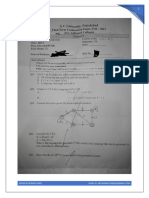week 5
1.
min=max=None
def get_max(L):
maxi = L[0]
for x in L:
if x > maxi:
maxi = x
return maxi
# get the minimum
def get_min(L):
mini = L[0]
for x in L:
if x < mini:
mini = x
return mini
# get the range
def get_range(L):
maxi = get_max(L)
mini = get_min(L)
return maxi - mini
2.
def is_perfect(num):
# Factor sum
fsum = 0
for f in range(1, num):
if num % f == 0:
fsum += f
# fsum == num is a Boolean expression
# It will evaluate to True if num is a perfect number
# And False otherwise
return fsum == num
print(is_perfect(int(input())))
3.
def distance(word_1,word_2):
if(len(word_1)!=len(word_2)):
return -1
else:
letters='abcdefghijklmnopqrstuvwxyz'
size=len(word_1)
dist=0
for i in range(size):
dist+=abs(letters.index(word_1[i])-letters.index(word_2[i]))
return dist
4.
def is_magic(mat):
# first get the dimension of the matrix
m = len(mat)
# the sum of the two diagonals
d1sum, d2sum = 0, 0
# (i, i) goes from top-left -> bottom-right
# (i, m - i - 1) goes from top-right -> bottom-left
# note that a single loop is enough; no nesting required
for i in range(m):
d1sum += mat[i][i]
d2sum += mat[i][m - i - 1]
# if the two diagonal sums are unequal, we can return NO
# unnecessary computation can be avoided
if not(d1sum == d2sum):
return 'NO'
# get row-sum and column-sum
for i in range(m):
rsum, csum = 0, 0
for j in range(m):
rsum += mat[i][j]
csum += mat[j][i]
if not(rsum == csum == d1sum):
return 'NO'
# if the code reaches this level
# then all requirements of a magic-square are satisfied
# so we can safely return YES
return 'YES'
5.
def transpose(mat):
mat2=[]
row=len(mat)
col=len(mat[0])
for i in range(col):
r=[]
for j in range(row):
r.append(mat[j][i])
mat2.append(r)
return mat2
Week 6 GRPA
1.
def get_toppers(scores_dataset, subject, gender):
# Filter the dataset based on gender
filtered_data = [data for data in scores_dataset if data['Gender'] == gender]
# Find the highest score for the given subject among the filtered data
highest_score = max(filtered_data, key=lambda x: x[subject])[subject]
# Get the names of students who have scored the highest in the subject
toppers = [data['Name'] for data in filtered_data if data[subject] ==
highest_score]
return toppers
2.
def freq_to_words(words):
word_freq_dict = {}
# Count the frequency of each word
for word in words:
word_freq_dict[word] = word_freq_dict.get(word, 0) + 1
# Create a dictionary with the frequency as key and a list of words as value
freq_to_words_dict = {}
for word, freq in word_freq_dict.items():
if freq not in freq_to_words_dict:
freq_to_words_dict[freq] = []
freq_to_words_dict[freq].append(word)
return freq_to_words_dict
3.
def rotate(mat):
# Get the number of rows and columns in the matrix
rows = len(mat)
cols = len(mat[0])
# Create a new matrix with swapped rows and columns
rotated_mat = [[0 for _ in range(rows)] for _ in range(cols)]
# Copy the elements from the original matrix to the rotated matrix
for i in range(rows):
for j in range(cols):
rotated_mat[j][rows - 1 - i] = mat[i][j]
return rotated_mat
4.
def two_level_sort(scores):
# Level-1 sorting: Sort the list of tuples based on marks in ascending order
for i in range(len(scores)):
for j in range(i + 1, len(scores)):
if scores[i][1] > scores[j][1]:
scores[i], scores[j] = scores[j], scores[i]
# Level-2 sorting: Sort the students with equal marks alphabetically by their
names
for i in range(len(scores) - 1):
j = i + 1
while j < len(scores) and scores[i][1] == scores[j][1]:
if scores[i][0] > scores[j][0]:
scores[i], scores[j] = scores[j], scores[i]
j += 1
return scores





























